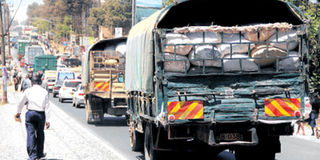Farmers fault move to empty maize reserves

Lorries deliver maize to an NCPB depot in Eldoret town this year. Maize flour prices have escalated in the past eight months. PHOTO | JARED NYATAYA | NATION MEDIA GROUP
What you need to know:
- The National Cereals and Produce Board (NCPB) on Tuesday cut the price of maize to Sh2,300 per bag and released 2.4 million bags from the strategic reserve.
- According to the government, the country had 14.6 million bags of maize as at September 1. Of these, farmers are hoarding 6.7 million bags, traders 2.4 million and millers 1.2 million bags in their warehouses.
Suspicion is growing about the government’s decision to empty its strategic grain reserve and sell maize to millers at a low price, just a few weeks to the harvesting season in the country’s food basket.
The National Cereals and Produce Board (NCPB) on Tuesday cut the price of maize to Sh2,300 per bag and released 2.4 million bags from the strategic reserve. The government said the move would check the runaway flour prices. This is the largest number of bags NCPB has released at a go in recent years.
Maize flour prices have been escalating in the past eight months. Data from the Kenya National Bureau of Statistics released this week indicates that the price of a two-kilogram packet of maize flour rose to an average Sh115 last month, up from Sh88 in January.
The government says that releasing maize to millers will stabilise the market by pushing down the price of the staple food. “In any situation, we need to balance the interests of all stakeholders,” Principal Secretary for Agriculture Cecily Kariuki told Sunday Nation.
“Our intention is to influence the supposed escalation of prices on the consumer side,” she said.
But similar price manoeuvres have often ended up hurting farmers or consumers, instead of lowering the price of maize flour. This price is mainly dictated by the cost of buying and producing maize.
In April, the release of 500,000 bags by NCPB failed to achieve the intended purpose after millers shunned the maize citing quality concerns. At that time, the price of maize flour was Sh104 for a 2kg packet. Both millers and farmers have for a long time been pressuring the government to allow market forces to dictate the prices.
Kenya is a maize deficit country. It depends on inflows from neighbouring states to meet the demand.
Data from Regional Agricultural Trade Intelligence Network (Ratin), a software run by Eastern African Grain Council that monitors cross-border trade across the East Africa Community, shows that an average 1,200 tonnes of maize crosses into Kenya from Uganda each day.
But these imports have not helped to bring down the cost of the staple food as cartels wanting to profit from a deficit hold on to these consignments and sell them later to millers at hefty profits.
According to the government, the country had 14.6 million bags of maize as at September 1. Of these, farmers are hoarding 6.7 million bags, traders 2.4 million and millers 1.2 million bags in their warehouses.
The NCPB, the country’s main grain bank, is the largest buyer of maize in Kenya. When it sets a price, dealers lower or increase their prices to match what it has offered, creating a ripple effect in the market. Currently, the price of maize across major towns is Sh2,900 per 90-kg bag, except in Kisumu where it is retailing at Sh3,100.
Releasing such a huge quantity of maize into the market, and at Sh2,300, just when most farmers in the north rift are expecting the next harvest, is likely to benefit the top players. The greatest losers will be small scale farmers as they will have to sell their produce at lower prices. Large scale farmers and dealers will most likely hold out.
According to the Kenya Farmers Association (KFA), it costs Sh1,800 to produce a bag of maize in Kitale.
“Large scale farmers who have their own drying and storage systems will likely hoard their maize. But small scale farmers, who are the majority, will have to sell immediately and suffer loses,” said the association’s director Menjo Kipkorir.
Matters have been complicated further by the impending El-Nino rains, predicted to commence at the start of the harvesting period. This could leave farmers with no option but to sell at whatever price to avoid losses.
The other option is to dry the maize and store it, but high prices of electricity and fuel could make this prohibitive. Also, only maize whose moisture content is not above 18 per cent can be dried in the machines. This means the maize should not have been rained on and it should have stayed in the fields for some weeks after maturity.
“With the coming rains, driers are going to exploit farmers, just like in the past. I’m foreseeing a situation where we could be protesting at NCPB offices, like we did last December, since we are clearly headed for a crisis,” said Mr Menjo.
The Sunday Nation learnt that the 10,000-acre Galana Kulalu Irrigation project is also expecting its first harvest, which will further complicate matters for farmers. The Sh260 billion scheme is a partnership between the government and private players.
Meanwhile, KFA says the move to empty the national grain reserves could actually be aimed at creating room for incoming maize, much more than easing the cost of the staple crop.
The Jubilee government has been struggling to prove the viability of the Galana project, which has been plagued with criticism. The opposition Cord says that growing maize under irrigation is expensive.
And even within the ruling coalition, URP has treated the irrigation scheme with suspicion as residents of the Rift Valley, where the political party draws its support, are the main producers of maize in Kenya.
In July, there were objections by the URP wing of government over relinquishing of the irrigation docket from Agriculture ministry, whose CS Felix Koskey is on suspension, to the Water ministry under Cabinet Secretary Eugene Wamalwa — an appointee of President Uhuru Kenyatta (TNA).
These latest developments could drive the wedge further in the TNA-URP coalition.





